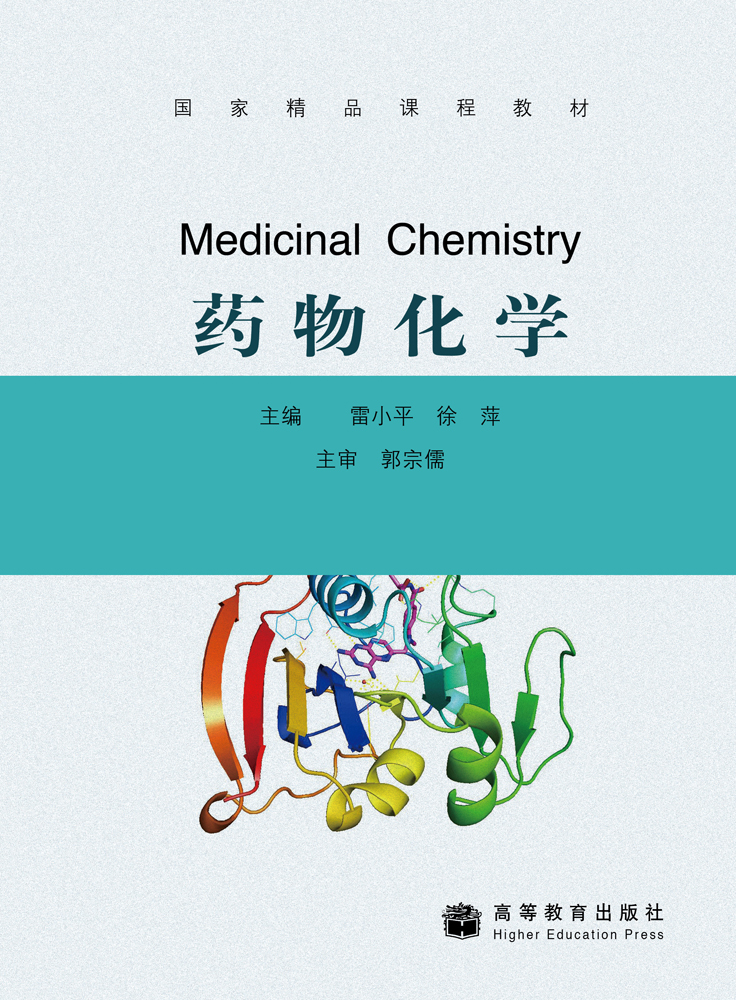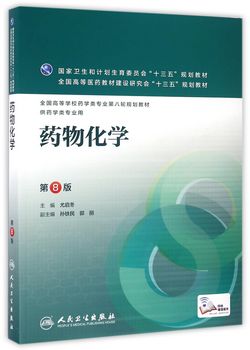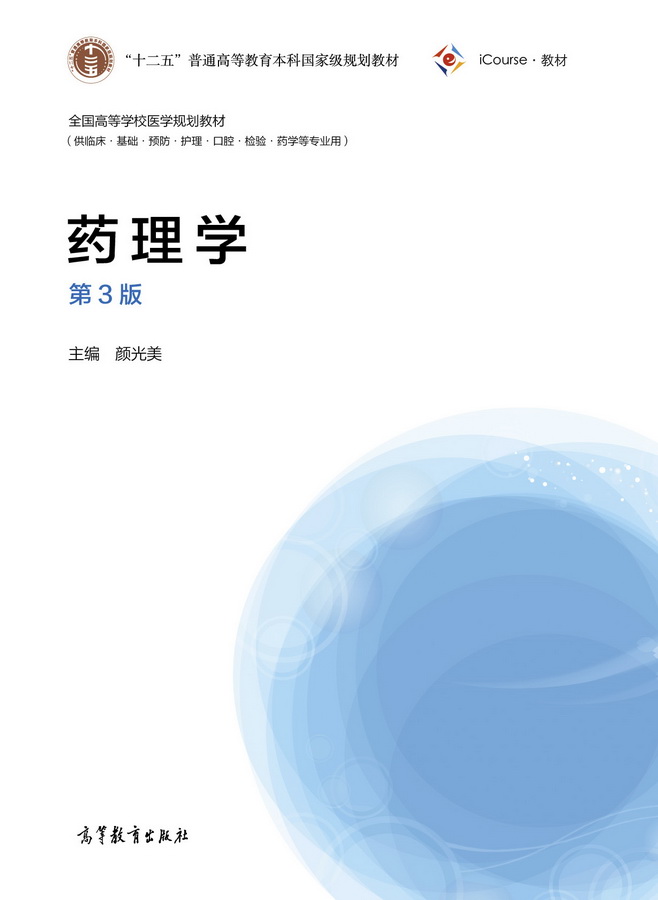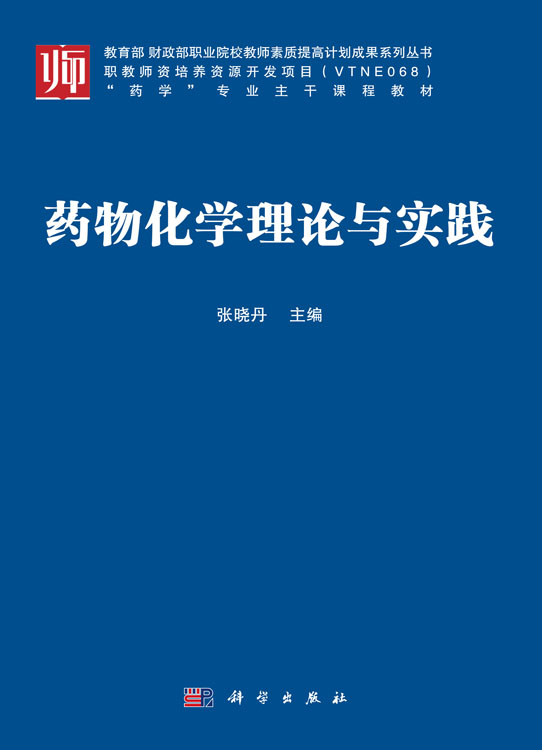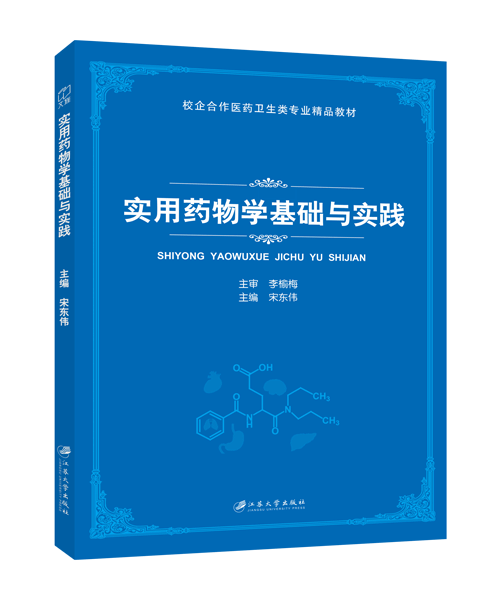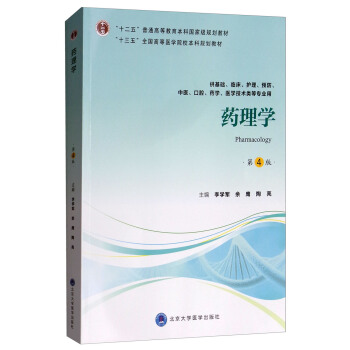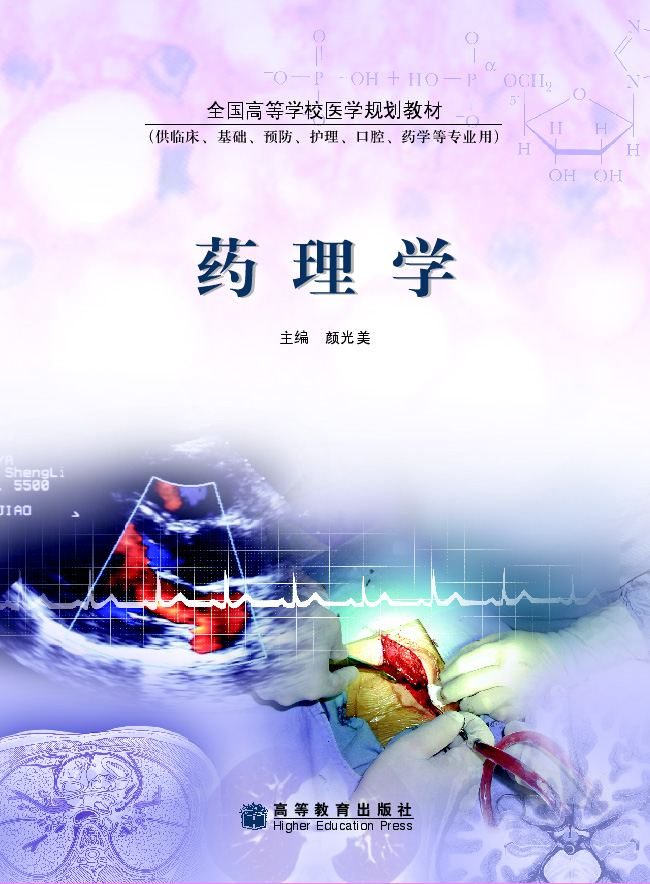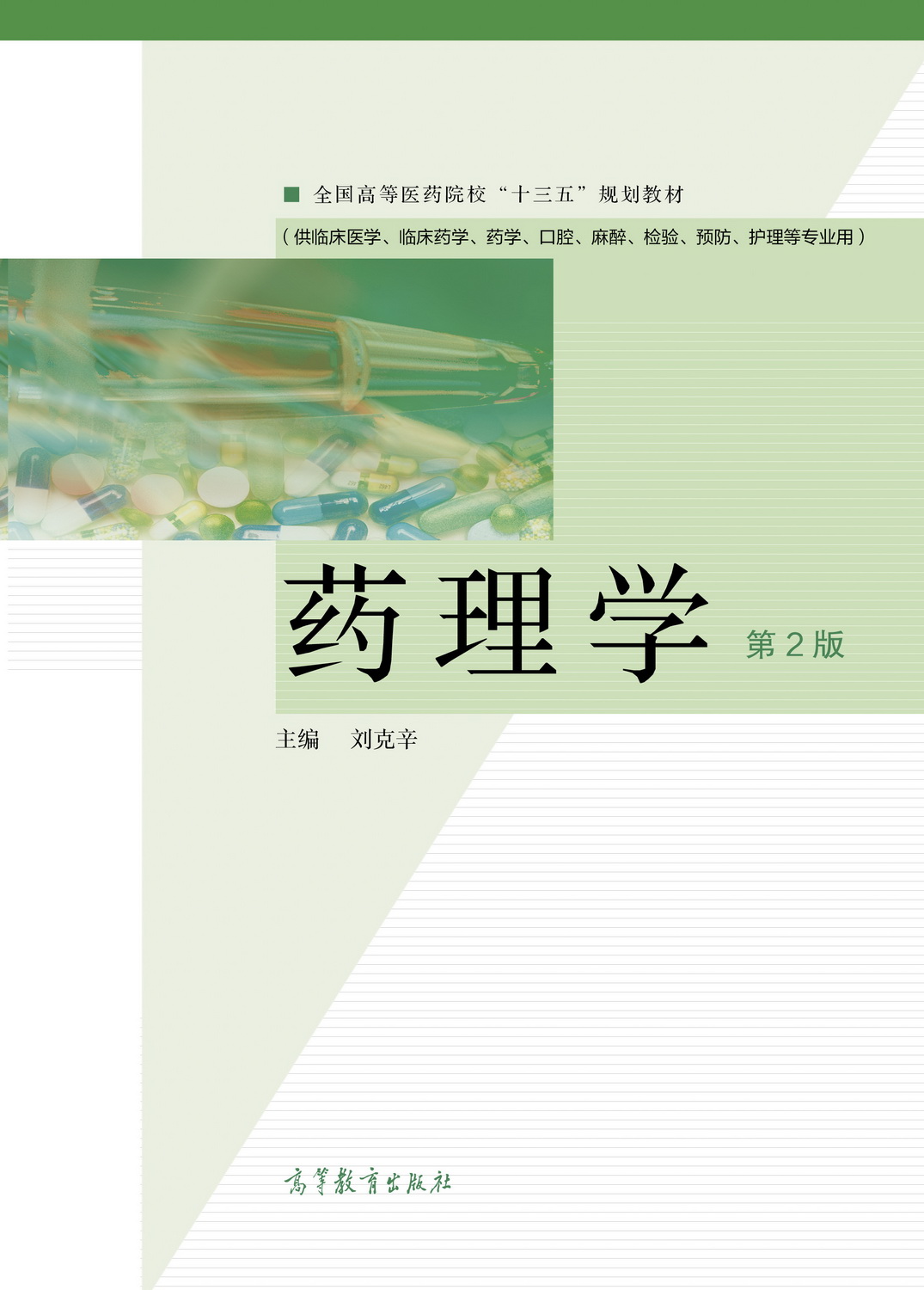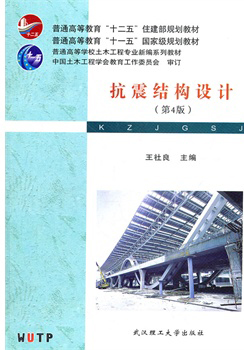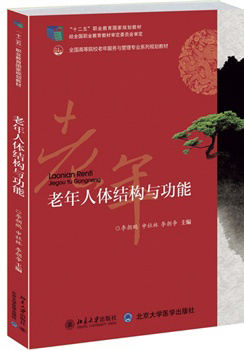- 高等教育出版社
- 9787040279818
- 1版
- 194862
- 42252346-4
- 平装
- 16开
- 2010-01-06
- 1130
- 706
- 医学
- 药学
- R914
- 药学
- 本科
本书是由获得国家级、省级和校级药物化学精品课程的院校联合推出的。全书前六部分按药物治疗领域分类叙述,即感染性疾病和癌症、中枢神经系统疾病和疼痛、传入与传出神经系统疾病和麻醉用药、心血管系统疾病、胃肠道系统疾病和内分泌系统疾病,第七部分讨论药物化学基本原理,共26章。本书以药物作用的靶标和分子作用机制为基础,在系统介绍药物化学基本理论的同时,注重把学科的新发展、新理论、新靶标和各系统的新药介绍给读者,对已有知识进行更新;编写中以药物的发展和构效关系为主线,从分子水平阐明药物化学结构与生物活性关系的内在规律。同时,用计算机辅助药物设计手段描述药物分子与靶标分子相互作用的分子模拟过程。
本书适用于高等院校本科药学专业“药物化学”课程教学,还可供从事新药开发、药物生产、临床药学等药学工作者参考。
第一章 绪论
一、药物化学的学科内容
二、药物化学的发展概况
三、药物化学的新发展
四、药物的名称
主要参考文献
第一部分 药物治疗领域一:感染性疾病和癌症
第二章 抗肿瘤药
第一节 导论
第二节 直接作用于DNA的药物
一、烷化剂
二、金属铂配合物
三、直接作用于DNA的天然产物
四、DNA拓扑异构酶抑制剂
第三节 抗代谢抗肿瘤的药物
一、嘧啶拮抗物
二、嘌呤拮抗物
三、叶酸拮抗物
第四节 抗有丝分裂的药物
一、微管组装抑制剂
二、微管稳定剂及微管组装促进剂
第五节 基于肿瘤信号转导机制的药物
一、蛋白激酶抑制剂
二、蛋白酶体抑制剂
主要参考文献
第三章 抗病毒药和抗艾滋病药
第一节 抗病毒药
一、概述
二、抑制病毒复制初始时期的药物
三、干扰病毒核酸复制的药物
第二节 抗艾滋病药
一、概述
二、逆转录酶抑制剂
三、HIV蛋白酶抑制剂
主要参考文献
第四章 抗菌药和抗真菌药
第一节 喹诺酮类抗菌药
一、发展概述
二、作用机制
三、构效关系
第二节 磺胺类药物及抗菌增效剂
一、发展概述
二、作用机制和构效关系
第三节 其他类抗菌药
一、異唑烷酮类
二、异喹啉类
三、硝基呋喃类
四、硝基咪唑类
第四节 抗结核药
一、抗生素类抗结核药
二、合成抗结核药
第五节 抗真菌药
一、作用于真菌膜上麦角甾醇的药物
二、麦角甾醇生物合成抑制剂———唑类抗真菌药物
三、麦角甾醇生物合成抑制剂———烯丙基胺和鲨烯环氧化酶抑制剂
四、其他抗真菌药物
主要参考文献
第五章 抗寄生虫药
第一节 抗疟药
一、疟原虫的生命周期和抗疟药物的作用环节
二、疟疾的预防和治疗药物
第二节 驱肠虫药
一、哌嗪类
二、咪唑类
三、其他驱肠虫药物
第三节 抗血吸虫药
主要参考文献
第六章 抗生素
第一节 导论
一、定义及分类
二、作用机制
第二节 β内酰胺类抗生素
一、概论
二、青霉素类
三、头孢菌素类
四、非经典的β内酰胺抗生素
五、β内酰胺酶抑制剂
第三节 氨基糖苷类抗生素
一、硫酸链霉素
二、卡那霉素及其衍生物
三、庆大霉素C及其衍生物
第四节 大环内酯类抗生素
一、红霉素及其衍生物
二、麦迪霉素及其衍生物
三、螺旋霉素及其衍生物
第五节 四环素类抗生素
一、概论
二、作用机制
三、物理性质和化学性质
第六节 其他抗生素
主要参考文献
第二部分 药物治疗领域二:中枢神经系统疾病和疼痛
第七章 镇静催眠药和抗癫痫药
第一节 镇静催眠药
一、苯二氮忯类药物
二、非苯二氮忯类药物
三、其他镇静催眠药
第二节 抗癫痫药
一、巴比妥类及其同型物
二、二苯并氮杂忯类
三、脂肪羧酸类
四、GABA类似物类
五、其他抗癫痫药
主要参考文献
第八章 抗精神失常药
第一节 抗精神病药
一、吩噻嗪类
二、硫杂蒽类
三、丁酰苯类
四、苯酰胺类
五、二苯并二氮忯类和苯并氧氮忯类
六、其他抗精神失常药
第二节 抗抑郁药
一、去甲肾上腺素重摄取抑制剂
二、羟色胺重摄取抑制剂
三、单胺氧化酶抑制剂
四、新抗抑郁药
第三节 抗焦虑药和抗躁狂药
一、抗焦虑药
二、抗躁狂药
主要参考文献
第九章 抗老年痴呆药
第一节 乙酰胆碱酯酶抑制剂
第二节 NMDA受体拮抗剂
第三节 中枢兴奋剂类益智药
第四节 目前研发领域及展望
一、中枢M受体激动剂
二、β和γ分泌酶抑制剂
三、其他研究领域
主要参考文献
第十章 抗帕金森病药
第一节 Dopamine受体激动剂
第二节 Dopamine替代物
第三节 Dopamine释放剂
第四节 单胺氧化酶B抑制剂和儿茶酚O甲基转移酶抑制剂
第五节 辅助治疗药
一、抗胆碱药
二、抗抑郁药
第六节 其他抗帕金森病药
主要参考文献
第十一章 阿片样镇痛药
第一节 吗啡及相关的阿片样激动剂
一、天然阿片生物碱类
二、Morphine的结构修饰
第二节 合成镇痛药
一、吗啡喃类
二、苯吗喃类
三、哌啶类
四、氨基酮类
五、环己烷衍生物
六、氨基四氢萘类
第三节 内源性阿片样肽类
第四节 阿片受体模型及μ受体激动剂的构效关系
一、阿片受体
二、μ受体选择性激动剂构效关系
主要参考文献
第十二章 非甾体抗炎药
第一节 非甾体抗炎药的作用机制
一、炎症的机制
二、前列腺素及相关物质的生物合成和作用
三、非甾体抗炎药的作用机制
第二节 解热镇痛药
一、苯胺类
二、水杨酸类
三、吡唑酮类
第三节 非甾体抗炎药
一、,吡唑烷二酮类
二、芳基烷酸类
三、N芳基邻氨基苯甲酸类
四、,苯并噻嗪类
五、COX选择性抑制剂
第四节 改善病情的抗风湿药
第五节 痛风治疗药物
一、抗血中尿酸过高的药物
二、抗急性痛风性关节炎药物
主要参考文献
第三部分 药物治疗领域三:外周神经系统疾病和麻醉
第十三章 影响胆碱能神经系统的药物
第一节 M受体激动剂
一、胆碱酯类M受体激动剂
二、生物碱类M受体激动剂
三、选择性作用于M受体亚型的激动剂
第二节 乙酰胆碱酯酶抑制剂
一、乙酰胆碱酯酶催化乙酰胆碱水解的机制
二、可逆性乙酰胆碱酯酶抑制剂
三、不可(难)逆性乙酰胆碱酯酶抑制剂
四、乙酰胆碱酯酶复活剂
第三节 M受体拮抗剂
一、茄科生物碱类M受体拮抗剂
二、合成的M受体拮抗剂
三、选择性作用于M受体亚型的拮抗剂
第四节 N受体拮抗剂
一、生物碱类N受体拮抗剂
二、合成的N受体拮抗剂
主要参考文献
第十四章 影响肾上腺素能神经系统的药物
第一节 导论
第二节 去甲肾上腺素的生物合成、代谢和作用机制
一、生物合成与代谢
二、作用机制
第三节 α肾上腺素受体激动剂
一、α和β受体激动剂
二、α受体激动剂
三、α受体激动剂
四、构效关系
第四节 α肾上腺素受体拮抗剂
一、非选择性α受体拮抗剂
二、选择性α受体拮抗剂
三、选择性α受体拮抗剂
第五节 β肾上腺素受体激动剂
一、非选择性β受体激动剂
二、选择性β受体激动剂
三、选择性β受体激动剂
四、构效关系
第六节 β肾上腺素受体拮抗剂
一、概述
二、β受体拮抗剂的分类
三、构效关系
主要参考文献
第十五章 麻醉药
第一节 全身麻醉药
一、吸入麻醉药
二、静脉麻醉药
第二节 局部麻醉药
一、普鲁卡因的发现
二、局部麻醉药的结构类型
三、局部麻醉药的构效关系
四、局部麻醉药的作用机制
主要参考文献
第四部分 药物治疗领域四:心血管系统疾病
第十六章 心血管系统药物
第一节 抗心律失常药
一、抗心律失常药分类
二、作用于离子通道的药物
三、β受体拮抗剂
第二节 抗心绞痛药
一、NO供体药物
二、钙通道阻滞剂
第三节 抗高血压药
一、影响肾素血管紧张素醛固酮系统的药物
二、作用于离子通道的药物
三、其他抗高血压药
第四节 血脂调节药
一、主要降低TG和VLDL的药物
二、主要降低TC和LDL的药物
第五节 强心药
一、强心苷类药物
二、非强心苷类药物
第六节 抗血栓药
一、抗血小板药
二、抗凝血药
三、血栓溶解药
主要参考文献
第十七章 利尿药
第一节 碳酸酐酶抑制剂
第二节 渗透性利尿药
第三节 Na+K+Cl-同向转运抑制剂
第四节 Na+Cl-同向转运抑制剂
第五节 肾小管上皮Na+通道抑制剂
第六节 盐皮质激素受体拮抗剂
主要参考文献
第五部分 药物治疗领域五:胃肠道系统疾病
第十八章 抗溃疡药
第一节 H受体拮抗剂
一、咪唑类
二、呋喃类
三、噻唑类
四、哌啶甲苯类
五、H受体拮抗剂的构效关系
第二节 质子泵抑制剂
一、奥美拉唑和埃索美拉唑
二、其他质子泵抑制剂
三、质子泵抑制剂的构效关系
四、可逆的质子泵抑制剂
第三节 其他抗溃疡药
一、抗胆碱药
二、前列腺素
三、胃黏膜保护剂
主要参考文献
第十九章 胃动力药和止吐药
第一节 胃动力药
一、多巴胺D受体拮抗剂
二、HT受体激动剂
第二节 止吐药
一、作用机制和分类
二、HT受体拮抗剂
主要参考文献
第六部分 药物治疗领域六:内分泌系统疾病
第二十章 抗变态反应药
第一节 组胺H受体拮抗剂
一、经典的H受体拮抗剂
二、无嗜睡作用的H受体拮抗剂
第二节 抗白三烯药
一、白三烯受体拮抗剂
二、白三烯合成抑制剂
第三节 过敏介质释放抑制剂
主要参考文献
第二十一章 甾体激素及相关药物
第一节 甾体结构和命名
一、甾体的结构骨架
二、甾体化合物的命名
第二节 甾体激素生物合成
第三节 甾体激素受体
一、甾体激素的作用机制
二、甾体激素受体的结构
第四节 雌激素及相关药物
一、内源性甾体雌激素及其衍生物
二、非甾体雌激素
三、选择性雌激素受体调节剂
四、芳构化酶抑制剂
第五节 雄激素及相关药物
一、内源性甾体雄激素及其衍生物
二、蛋白同化甾体
三、雄激素受体拮抗剂
四、α还原酶抑制剂
第六节 孕激素及相关药物
一、内源性甾体孕激素及其衍生物
二、睾酮衍生物
三、孕激素受体拮抗剂
第七节 肾上腺皮质激素及相关药物
一、内源性肾上腺皮质激素
二、糖皮质激素类药物
三、肾上腺皮质激素生物合成抑制剂
四、肾上腺皮质激素受体拮抗剂
第八节 甾体的一般合成方法
一、甾体药物的半合成
二、甾体药物的全合成
主要参考文献
第二十二章 降血糖药
第一节 胰岛素
一、胰岛素
二、胰岛素类似物及制剂
第二节 口服降血糖药
一、胰岛素分泌促进剂
二、胰岛素增敏剂
三、二肽基肽酶Ⅳ抑制剂
四、α葡萄糖苷酶抑制剂
主要参考文献
第二十三章 维生素
第一节 水溶性维生素
一、维生素B
二、维生素B
三、维生素C
四、维生素B
五、泛酸
六、叶酸
七、其他水溶性维生素
第二节 脂溶性维生素
一、维生素A
二、维生素D
三、维生素E
四、维生素K
主要参考文献
第七部分 药物化学基本原理
第二十四章 药物分子设计概论
第一节 导论
一、药物的属性
二、创制新药的四要素
第二节 分子的多样性———先导化合物的发现
一、天然产物具有多样性,是先导化合物的重要来源
二、组合化学
三、随机筛选
四、虚拟筛选
第三节 分子的互补性———先导化合物的发现
一、分子识别
二、基于受体结构的药物分子设计
三、反义寡核苷酸
第四节 分子的相似性———先导化合物的发现和优化
一、基于内源性配体分子的药物设计
二、肽模拟物
三、生物电子等排置换
四、Topliss决策法
五、过渡态类似物
六、剖裂物、同系物、插烯物、合环和开环
七、药物合成的中间体
八、基于代谢转化
第五节 药物分子设计的策略
一、苗头化合物、先导物和候选药物
二、药物分子为宏观性质和微观结构的集合
三、药效团和结构骨架
主要参考文献
第二十五章 药物代谢反应
第一节 导论
第二节 药物代谢的酶
一、细胞色素P酶系
二、还原酶系
三、过氧化物酶和单加氧酶
四、水解酶
第三节 第Ⅰ相的生物转化
一、氧化反应
二、还原反应
三、脱卤素反应
四、水解反应
第四节 第Ⅱ相的生物转化
一、葡糖醛酸的结合
二、硫酸酯化结合
三、与氨基酸的结合
四、谷胱甘肽结合
五、乙酰化结合
六、甲基化结合
第五节 药物代谢在药物研究中的作用
一、设计和发现新药
二、优化药物的药动学性质
三、解释药物的作用机制
主要参考文献
第二十六章 构效关系及计算机辅助药物设计
第一节 药物的分类
一、药物在体内的过程
二、药物的分类
三、药物的药效团
第二节 药物的理化性质与药效
一、溶解度和分配系数对药效的影响
二、药物的酸碱性和解离度对药效的影响
第三节 药物受体相互作用与药效
一、药物与受体结合方式对药效的影响
二、药物的功能基团对药效的影响
三、药物电荷分布对药效的影响
四、药物的立体化学对药效的影响
第四节 二维定量构效关系
一、二维定量构效关系简介
二、Hansch方法
三、Hansch方法在药物设计中的应用
第五节 三维定量构效关系及计算机辅助药物设计
一、基于配体的药物设计
二、基于受体的药物设计
主要参考文献
中英文专业词汇对照及索引
英中文专业词汇对照及索引
Chapter 1 Introduction
1.1.1 The Discipline of Medicinal Chemistry
1.1.2 History and Evolution of Medicinal Chemistry
1.1.3 Recent Progress of Medicinal Chemistry
1.1.4 Nomenclature of Drug Substances
References
Part Ⅰ.Therapeutic Areas Ⅰ: Infectious Diseases and Cancer
Chapter 2 Antineoplastic Agents
2.1 Introduction
2.2 Agents Directly Acting on DNA
2.2.1 Alkylating Agents
2.2.2 Platinum Complexes
2.2.3 Natural Products Directly Acting on DNA
2.2.4 DNA Topoisomerase Inhibitors
2.3 Antimetabolite Antitumor Agents
2.3.1 Pyrimidine Antagonists
2.3.2 Purine Antagonists
2.3.3 Antifolates
2.4 Antimitotic Agents
2.4.1 Inhibitors of Microtubule Assembly
2.4.2 Microtubule Stabilizers and Promotors of Microtubule Assembly
2.5 Tumor Signal Transduction Pathway Mechanism based Agents
2.5.1 Protein Kinase Inhibitors
2.5.2 Proteasome Inhibitors
References
Chapter 3 Antiviral Agents and Anti-AIDS Agents
3.1 Antiviral Agents
3.1.1 Introduction
3.1.2 Agents Inhibiting Early Viral Replication
3.1.3 Agents Interfering with Viral Nucleic Acid Replication
3.2 Anti AIDS Agents
3.2.1 Introduction
3.2.2 Inhibitors of Reverse Transcriptase
3.2.3 HIV Protease Inhibitors
References
Chapter 4 Antimicrobial and Antifungal Agents
4.1 Antimicrobial Quinolones
4.1.1 Development History
4.1.2 Mechanism of Action
4.1.3 Structure activity Relationships
4.2 Antimicrobial Sulfonamides and Antibacterial Synerists
4.2.1 Development History
4.2.2 Action Mechanism and Structure activity Relationships
4.3 Other Antimicrobial Agents
4.3.1 Oxazolidinones
4.3.2 Isoquinolines
4.3.3 Nitrofurans
4.3.4 Nitroimidazoles
4.4 Tuberculostatics
4.4.1 Antitubercular Antibiotics
4.4.2 Synthetic Antitubercular Agents
4.5 Antifungal Drugs
4.5.1 Agents on Ergosterol of Fungi Membrane
4.5.2 Ergosterol Biosynthesis Inhibitors
4.5.3 Allylamine and Squalene Epoxidase Inhibitors
4.5.4 Other Antifungal Drugs
References
Chapter 5 Antiparasitic Drugs
5.1 Antimalarial Drugs
5.1.1 Lifecycle of Plasmodial and Role for Antimalarial Drugs
5.1.2 Drugs for Prevention and Treatment of Malaria Disease
5.2 Anthelmintic Drug
5.2.1 Piperazines
5.2.2 Imidazoles
5.2.3 Other Anthelmintic Drugs
5.3 Antischistosomals
References
Chapter 6 Antibiotics
6.1 Introduction
6.1.1 Definition and Classification
6.1.2 Mechanism of Action
6.2 β Lactam Antibiotics
6.2.1 Introduction
6.2.2 Penicillins
6.2.3 Cephalosporins
6.2.4 Nonclassical β Lactam Antibiotics
6.2.5 β Lactamase Inhibitors
6.3 Aminoglycoside Antibiotics
6.3.1 Streptomycin Sulfate
6.3.2 Kanamycin and Derivatives
6.3.3 Gentamicin C and Derivatives
6.4 Macrolide Antibiotics
6.4.1 Erythromycin and Derivatives
6.4.2 Midecamycin and Derivatives
6.4.3 Spiramycin and Derivatives
6.5 Tetracycline Antibiotics
6.5.1 Introduction
6.5.2 Mechanism of Action
6.5.3 Physico chemical Properties of Tetracyclines
6.6 Other Antibiotics
References
Part Ⅱ.Therapeutic Areas Ⅱ: Central Nervous System Diseases and Pain
Chapter 7 Sedative-Hypnotics and Antiepileptics
7.1 Sedative-hypnotics
7.1.1 Benzodiazepines
7.1.2 Nonbenzodiazepines
7.1.3 Other Sedative-Hypnotics Drugs
7.2 Antiepileptics
7.2.1 Barbiturates and Homotypical Drugs
7.2.2 Dibenzoazepines
7.2.3 Caboxylic Acids
7.2.4 Analogues of GABA
7.2.5 Other Antiepileptics
References
Chapter 8 Psychotherapeutic Drugs
8.1 Antipsychotic Drugs
8.1.1 Phenothiazines
8.1.2 Thioxanthenes
8.1.3 Butyrophenones
8.1.4 Benzamides
8.1.5 Dibenzodiazepines and Dibenzoxazepines
8.1.6 Others Psychotherapeutic Drugs
8.2 Antidepressant Drugs
8.2.1 Norepinephrine reuptake Inhibitors
8.2.2 Serotonin reuptake Inhibitors
8.2.3 Monoamine Oxidase Inhibitors
8.2.4 New Antidepressant Drugs
8.3 Antianxiety Drugs and Antimanic Drugs
8.3.1 Antianxiety Drugs
8.3.2 Antimanic Drugs
References
Chapter 9 Antidementia Drugs
9.1 Cholinesterase Inhibitors
9.2 NMDA Receptor Antagonists
9.3 Central Stimulant Nootropics
9.4 Current R&D Areas and Perspective
9.4.1 CNS M1 Receptor Agonists
9.4.2 βand γ Secretase Inhibitors
9.4.3 Other Areas
References
Chapter 10 Antiparkinsonian Agents
10.1 Dopamine Receptor Stimulants
10.2 Dopamine Replacers
10.3 Dopamine Releasers
10.4 MAO B Inhibitors and COMT Inhibitors
10.5 Agnets for Assistant Therapy of Parkison Diseases
10.5.1 Anticholinergic Drugs
10.5.2 Antidepressant Drugs
10.6 Other Antiparkinsonian Agents
References
Chapter 11 Opioid Analgesics
11.1 Morphine and Related Opioid Agonists
11.1.1 Natural Opioid Alkaloids
11.1.2 Modification of Morphine
11.2 Synthetic Analgesics
11.2.1 Morphinans
11.2.2 Benzomorphans
11.2.3 Piperidines
11.2.4 Aminoketones
11.2.5 Cyclohexane Derivates
11.2.6 Aminotetralines
11.3 Endogenous Opioid Peptides
11.4 Opioid Receptor and Structure Activity Relationships of Opioid Analgesics
11.4.1 Opioid Receptor
11.4.2 Structure Activity Relationships of Opioid Analgesics
References
Chapter 12 Nonsteroidal Antiinflammatory Drugs
12.1 Action Mechanism of Nonsteroidal Anti inflammatory Drugs
12.1.1 Mechanism of Inflammation
12.1.2 Biosynthesis and Action of Prostaglandins and Related Substances
12.1.3 Action Mechanism of NSAID
12.2 Antipyretic Analgesics
12.2.1 Anilines
12.2.2 Salicylic Acids
12.2.3 Pyrazolones
12.3 Nonsteroidal Anti inflammatory Drugs
12.3.1 3,5 Pyrazolidiones
12.3.2 Aryl Carboxylic Acids
12.3.3 N Aryl Anthranilic Acids
12.3.4 1,2 Benzothiazides
12.3.5 Selective COX 2 Inhibitors
12.4 Disease modifying Antirheumatic Drugs,DMARD
12.5 Drugs Used to Treat Gout
12.5.1 Anti Hyperuricemia
12.5.2 Drugs Used to Treat Acute Gouty Arthritis
References
Part Ⅲ.Therapeutic Areas Ⅲ: Peripheral Nervous System Diseases and Anesthesia
Chapter 13 Drugs Affecting Cholinergic Neurotransmission
13.1 Muscarinic Receptor Agonists
13.1.1 Choline Ester Muscarinic Receptor Agonists
13.1.2 Alkaloid Muscarinic Receptor Agonists
13.1.3 Muscarinic Receptor Subtype Selective Agonists
13.2 Acetylcholinesterase Inhibitors
13.2.1 Acetylcholinesterase Catalytic Mechanism
13.2.2 Reversible Inhibitors of Acetylcholinesterase
13.2.3 Irreversible Inhibitors of Acetylcholinesterase
13.2.4 Cholinesterase Reactivators
13.3 Muscarinic Receptor Antagonists
13.3.1 Solanaceous Alkaloid Muscarinic Receptor Antagonists
13.3.2 Synthetic Muscarinic Receptor Antagonists
13.3.3 Muscarinic Receptor Subtype Selective Antagonists
13.4 Nicotinic Receptor Antagonists
13.4.1 Alkaloid Nicotinic Receptor Antagonists
13.4.2 Synthetic Nicotinic Receptor Antagonists
References
Chapter 14 Drugs Affecting Adrenergic Neurotransmission
14.1 Introduction
14.2 Biosynthesis,Metabolism,and Action Mechanism of Norepinephrine
14.2.1 Biosynthesis and Metabolism
14.2.2 Mechanism of Action
14.3 α-Adrenergic Agonists
14.3.1 αand β-Agonists
14.3.2 α1 -Agonists
14.3.3 α2 -Agonists
14.3.4 Structure-activity Relationships
14.4 α Adrenergic Antagonists
14.4.1 Nonselective α Antagonists
14.4.2 Selective α1 Antagonists
14.4.3 Selective α2 Antagonists
14.5 β-Adrenergic Agonists
14.5.1 Nonselective β-Agonists
14.5.2 Selective β1-Agonists
14.5.3 Selective β2-Agonists
14.5.4 Structure-activity Relationships
14.6 β Adrenergic Antagonists
14.6.1 Introduction
14.6.2 Classifications of β-Antagonists
14.6.3 Structure activity Relationships
References
Chapter 15 Anesthetic Agents
15.1 General Anesthetics
15.1.1 Inhalation Anesthetics
15.1.2 Intravenous Anesthetics
15.2 Local Anesthetics
15.2.1 Discovery of Procaine
15.2.2 Structure Types of Local Anesthetics
15.2.3 Structure activity Relationships of Local Anesthetics
15.2.4 Action Mechanism of Local Anesthetics
References
Part Ⅳ.Therapeutic Areas Ⅳ: Disease of Cardiovascular System
Chapter 16 Drugs Affecting the Cardiovascular System
16.1 Antiarrhythmic Drugs
16.1.1 Classification of Antiarrhythmic Drugs
16.1.2 Drugs Acting on Ion Channels
16.1.3 β Adrenergic Blockers
16.2 Antianginal Drugs
16.2.1 Nitric Oxide Donating Drugs
16.2.2 Calcium Channel Blockers
16.3 Antihypertensive Drugs
16.3.1 Drugs Affecting Renin Angiotensin Aldosterone System
16.3.2 Drugs Acting on Ion Channels
16.3.3 Miscellaneous Antihypertensive Drugs
16.4 Plasma Lipids Regulators
16.4.1 Drugs Reducing TG and VLDL
16.4.2 Drugs Reducing TC and LDL
16.5 Cardiotonic Agents
16.5.1 Cardiac Glycoside Drugs
16.5.2 Non cardiac Glycoside Drugs
16.6 Antithrombotic Drugs
16.6.1 Antipatelet Drugs
16.6.2 Anticoagulant Drugs
16.6.3 Thrombolytic Drugs
References
Chapter 17 Diuretics
17.1 Carbonic Anhydrase Inhibitors
17.2 Osmotic Diuretics
17.3 Inhibitors of Na+K+2Cl- Symport
17.4 Inhibitors of Na+Cl- Symport
17.5 Inhibitors of Renal Epithelial Na+ Channels
17.6 Mineralocorticoid Receptor Antagonists
References
Part Ⅴ.Therapeutic Areas V: Gastrointestinal Systemic Disease
Chapter 18 Antiulcer Drugs
18.1 H2 Receptor Antagonists
18.1.1 Imidazole Derivatives
18.1.2 Furan Derivatives
18.1.3 Thiazole Derivatives
18.1.4 Piperidyl Toluene Derivatives
18.1.5 SAR of H2 Receptor Antagonist
18.2 Proton Pump Inhibitor
18.2.1 Omeprazole and Esomeprazole
18.2.2 Other Proton Pump Inhibitors
18.2.3 SAR of Proton Pump Inhibitors
18.2.4 Reversible Proton Pump Inhibitor
18.3 Other Antiulcer Drugs
18.3.1 Anticholinergic Agents
18.3.2 Prostaglandines
18.3.3 Gastric Mucosa Protectant
References
Chapter 19 Prokinetics and Antiemetics
19.1 Prokinetics
19.1.1 Dopamine D2 Receptor Antagonists
19.1.2 5 HT4 Receptor Agonists
19.2 Antiemetics
19.2.1 Classification and Mechanism of Action
19.2.2 5 HT3 Receptor Antagonists
References
Part Ⅵ.Therapeutic Areas Ⅵ: Endocrine System Diseases
Chapter 20 Anti-Allergic Drugs
20.1 Histamine H1 Receptor Antagonists
20.1.1 Classic Histamine H1 Receptor Antagonists
20.1.2 Nonsedating Histamine H1 Receptor Antagonists
20.2 Anti-leukotriene Drugs
20.2.1 Leukotriene Receptor Antagonists
20.2.2 Leukotriene Biosynthesis Inhibitors
20.3 Inhibitors of the Release of Allergic Mediators
References
Chapter 21 Steroid Hormones and Related Therapeutic Agents
21.1 Steroid Structure and Nomenclature
21.1.1 Steroid Backbones
21.1.2 Nomenclature of Steroids
21.2 Steroid Biosynthesis
21.3 Steroid Hormone Receptors
21.3.1 Mechanism of Steroid Hormone Action
21.3.2 Structure of Steroid Hormone Receptors
21.4 Estrogens and Related Drugs
21.4.1 Endogenous Steroidal Estrogens and Derivatives
21.4.2 Nonsteroidal Estrogens
21.4.3 Selective Estrogen Receptor Modulator,SERM
21.4.4 Aromatase Inhibitors
21.5 Androgens and Related Drugs
21.5.1 Endogenous Steroidal Androgens and Derivatives
21.5.2 Anabolic Androgenic Steroids
21.5.3 Androgen Receptor Antagonists
21.5.4 5α Reductase Inhibitors
21.6 Progestogens and Related Drugs
21.6.1 Endogenous Steroidal Progestogens and Derivatives
21.6.2 Testosterone Derivatives
21.6.3 Progestogen Receptor Antagonists
21.7 Adrenal Cortical Hormones and Related Drugs
21.7.1 Endogenous Adrenal Cortical Hormones
21.7.2 Glucocorticoid Drugs
21.7.3 Adrenalcorticoid Biosynthesis Inhibitors
21.7.4 Adrenalcorticoid Receptor Antagonists
21.8 General Synthetic Methodology of Steroids
21.8.1 Semi synthesis of Steroid Drugs
21.8.2 Total synthesis of Steroid Drugs
References
Chapter 22 Hypoglycemic Drugs
22.1 Insulin
22.1.1 Insulin
22.1.2 Insulin Analoges and Formulations
22.2 Oral Hypoglycemic Drugs
22.2.1 Promoter to Insulin Secretion
22.2.2 Insulin Enhancers
22.2.3 Dipeptidyl Peptidase Ⅳ Inhibitors
22.2.4 α Glucosidase Inhibitors
References
Chapter 23 Vitamins
23.1 Water soluble Vitamins
23.1.1 Vitamin B1
23.1.2 Vitamin B2
23.1.3 Vitamin C
23.1.4 Vitamin B6
23.1.5 Pantothenic Acid
23.1.6 Folic Acid
23.1.7 Miscellaneous Water soluble Vitamins
23.2 Lipid soluble Vitamins
23.2.1 Vitamin A
23.2.2 Vitamin D
23.2.3 Vitamin E
23.2.4 Vitamin K
References
Part Ⅶ.Priciples of Medicinal Chemistry
Chapter 24 Outline of Molecular Drug Design
24.1 Introduction
24.1.1 Attributes of Drug
24.1.2 Four Elements of Drug Innovation
24.2 Molecular Diversity---Lead Discovery
24.2.1 Diverse Natural Products are Important Sources of Lead Compounds
24.2.2 Combinatorial Chemistry
24.2.3 Random Screening
24.2.4 Virtual Screening
24.3 Molecular Complementarity---Lead Discovery
24.3.1 Molecular Recognition
24.3.2 Structure-based Drug Design
24.3.3 Anti sense Oligonucleotide
24.4 Molecular Similarity---Lead Discovery and Optimization
24.4.1 Endogenous Ligand-based Drug Design
24.4.2 Peptidomimetics
24.4.3 Replacement of Bioisosteres
24.4.4 Topliss Decision Tree
24.4.5 Transition State Analogs
24.4.6 Dissection,Homologues,Vinylogues and Ring-chain Alteration
24.4.7 Synthetic Intermediates
24.4.8 Metabolism-based Drug Design
24.5 Strategy of Molecular Drug Design
24.5.1 Hit,Lead and Drug Candidate
24.5.2 Drug Molecule is the Assembly of Macroscopic Properties and Microscopic Structure
24.5.3 Pharmacophore and Scaffold
References
Chapter 25 Drug Metabolism
25.1 Introduction
25.2 Enzymes for Drug Metabolism
25.2.1 Cytochrome P 450 Enzyme System
25.2.2 Reductase
25.2.3 Peroxidases and Other Monooxygenases
25.2.4 Hydrolases
25.3 Phase ⅠBiotransformation
25.3.1 Oxidations
25.3.2 Reductions
25.3.3 Dehalogenation
25.3.4 Hydrolysis
25.4 Phase Ⅱ Biotransformation
25.4.1 Glucuronic acid Conjugation
25.4.2 Sulfate Conjugation
25.4.3 Conjugation with Amino Acid
25.4.4 Glutathione Conjugation
25.4.5 Acetylation
25.4.6 Methylation
25.5 Role of Drug Metabolism in Drug Research
25.5.1 Design and Discovery of New Drugs
25.5.2 Optimization of Drug Pharmacokinetics
25.5.3 Explaining Action Mechanism of Drugs
References
Chapter 26 Structure-activity Relationships and Computer Aided Drug Design
26.1 Classification of Drugs
26.1.1 Processes of Drug-organism Interaction
26.1.2 Classification of Drugs
26.1.3 Pharmacophore
26.2 Physicochemical Properties and Drug Action
26.2.1 Effects of Solubility and Partition Coefficient on Drug Action
26.2.2 Effects of Acidity,Alkality and Dissociation on Drug Action
26.3 Drug-receptor Interaction and Drug Effect
26.3.1 Effects of Drug-receptor Binding on Drug Action
26.3.2 Effects of Functional Groups on Drug Action
26.3.3 Effects of Charge Distribution on Drug Action
26.3.4 Effects of Stereochemistry on Drug Action
26.4 Two Dimension Quantitative Structure-activity Relationships
26.4.1 Outline of 2D QSAR
26.4.2 Hansch Method
26.4.3 Application of Hansch Method to Drug Design
26.5 3D QSAR and Computeraided Drug Design
26.5.1 Ligand based Approaches
26.5.2 Receptor-based Drug Design
References
Project lndex(Chinese/English)
Project lndex( English/Chinese)

